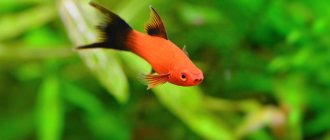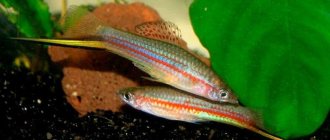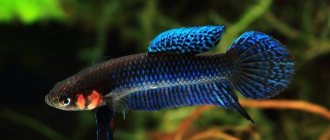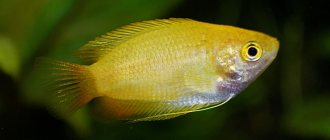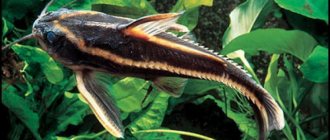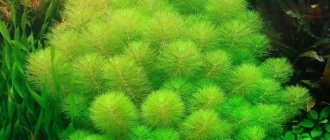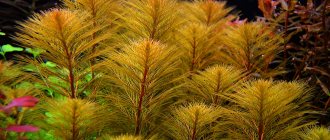Structure, appearance of gourami
Threadbearers or simply gourami are small fish, the length of which varies between 5-15 cm. Serpentine gourami in nature can reach 20-25 cm. Other species are up to 15 cm, but in an aquarium these fish almost never exceed 10 cm in length.
Beautiful and inquisitive gouramis from the labyrinth fish family are very popular among aquarists. They are quite unpretentious in care, they reproduce quite easily, since these fish tend to take care of their offspring. If the maintenance of gourami meets all standards, then the fish will be able to please your eyes for 7 years. That is why it is difficult to find an aquarium owner who has never introduced them into his pond.
The genus Gurami includes 6 species. The name Trichogaster (having threads on the belly) was given to the fish due to the thread-like fins located on the bellies of the fish, which serve as organs of touch and help to navigate in polluted waters with poor visibility.
The word "Gourami" in the Javanese language is used to refer to fish that stuck their "nose" out of the water.
Several decades ago, the name “threader” was used even more often than “gourami”. Often, “gourami” refers specifically to representatives of the genus Trichogaster.
Gourami breathe atmospheric air using a special organ - a labyrinth.
Habitat of gourami
These fish live in Southeast Asia (the Malay and Indochina peninsulas, the islands of Sumatra, Kalimantan) in the reservoirs of the Antilles in Central America.
The widest range is that of the spotted gourami. It lives over a vast territory, ranging from India to the Malay Archipelago. The Spotted Gourami comes in many color variations.
Pearl gourami lives everywhere on the islands of Borneo and Sumatra.
There is evidence that this species can be found on the island of Java. These fish can also be found near Bangkok, the reason for their appearance here is aquarists who release fish into open waters.
Moon gourami Trichogaster microlepis lives in Thailand and Cambodia. Serpentine Trichogaster pectoralis - in Eastern Thailand, southern Vietnam, Cambodia. Blue - in Sumatra.
The range of the serpentine is close to the ocean coast opposite Sri Lanka. It is not native to the island, but it has already successfully colonized the waters of the Antilles in Central America.
In addition, these fish are found in stagnant bodies of water, flowing waters of rivers, and streams that are seemingly unsuitable for life. Some species, such as spotted and brown gourami, tolerate slight increases in water salinity and are found in estuaries of rivers flowing into the ocean in tidal zones.
History of the discovery of gourami
Zolotnitsky N. F.;
P. Carbonnier and Meshchersky A.S. Pierre Carbonnier, a scientist from France, studied the issues of acclimatization of tropical fish in Europe. The species he was interested in included gouramis, medium-sized fish that constantly rise to the surface of the water. Despite the fact that gouramis were caught on different islands, the fish could not survive more than a day on the road. This was due to the fact that the fish were transported in wooden barrels, the top of which was completely closed to avoid water splashing out; this cut off the fish’s access to oxygen, which they could not do without, but no one knew about this yet.
Dozens of attempts were unsuccessful, and the fish were classified as problematic for transportation, stopping their distribution for more than 20 years.
Only at the end of the 19th century, one European, observing the behavior of gourami, noticed that from time to time they rise to the surface of the water to swallow a portion of air. Then he tried to transport the gourami again, but he filled the barrels with water less than halfway and did not additionally cover them with a lid. Thus, more than 1000 fish appeared in Europe for the first time and became very popular.
Care of offspring
Only the papa gourami looks after the nest with eggs, and he is very jealous of his duties. He carefully returns the eggs that have fallen out of the foam. About one and a half to two days pass and the larvae emerge from the eggs. And after another three days they will turn into full-fledged fry. If the larvae cannot swim on their own, then daddy makes sure that the babies do not sink to the bottom. Then the fry is already able to move independently. He no longer needs daddy's care and the male can also be removed. And by this time, the paternal gourami also begins to lose its parental instinct. He begins to get nervous because he is no longer able to keep track of the offspring that are spreading out in all directions, begins to show aggression and may even eat all of his offspring, which he so carefully looked after just recently .
After a couple of days, small gourami larvae can be seen in the nest.
While the eggs are ripening and the larvae are growing, you need to carefully monitor the water temperature in the spawning aquarium. After all, as soon as the fish feels that the temperature has begun to drop, he will immediately stop caring for the offspring, destroy the nest and eat the eggs and the babies that appear.
After the male has been removed, the foam nest begins to gradually fall apart on its own, and it is no longer needed. Babies should be fed first with ciliates, later switching to zooplankton. Since the fry grow at different speeds, those who grow faster must be removed, because they can mistake small things for food.
Only three weeks after hatching from the eggs, the babies will develop a labyrinthine apparatus, so the water in the “catch” should be clean and enriched with oxygen, with a constant temperature in the range of +27-29°C. You can begin to gradually reduce it after a month and a half.
Moving a nest from a community aquarium
If the fish spawned in a community aquarium, the nest must be moved, otherwise all the offspring will be eaten.
But what to do and how to breed if the process of building a nest has already begun in a general aquarium, where conditions for gourami spawning are not entirely suitable. In this case, let the pair spawn, and then carefully pick up the foam nest with eggs using a saucer and transfer it to an aquarium where the temperature is the same as in the general aquarium. Move the male there too so that he can continue caring for the offspring. And then the whole process is the same as if the fish laid eggs in a pre-prepared spawning area.
Reproduction of these beautiful labyrinth fish is not that difficult, and the joy from the process of watching the emergence of new lives is incomparable.
Source
Varieties of gourami
As mentioned above, “gourami” are four species from the genus Trichogaster:
The spotted gourami is an energetic and fairly large silver-colored fish with spots on the tail and subtle dark stripes.
Brown gourami. The body length of this fish can easily reach 16 cm in aquarium conditions, so it can rightfully be called the largest representative of the entire species. Despite its size, the serpentine (brown) gourami is a peace-loving fish that does not really like bright light.
The pearl gourami gets its name from the small white spots that look like pearls, which are located on the body of the fish.
Moon gourami has a silver body with a greenish tint. Males have a faint orange tint on their ventral fins.
Gourami also includes closely related species, for example:
The kissing gourami was named so due to its interesting form of behavior. Sometimes the fish come up to each other, swim side by side, and then at one moment lock their mouths. In fact, this is not “love” at all, but an attempt to establish one’s social status in the pack;
Grunting gourami - the name speaks for itself: the fish makes grumbling sounds reminiscent of the croaking of a frog. “The Grumpy” emits them while in an excited state, swimming at night to the surface of the water to capture the next portion of air;
The dwarf gourami is a miniature fish compared to its relatives, which grows no more than 4 cm;
Honey gourami is unpretentious. It got its name due to its color. Females and young fish are silver-brown in color with a chocolate stripe along the body. Adult males are honey-colored, the underbelly, head, and most of the anal fin are black-brown. The dorsal fin has a white and yellow border. Because a female and a male of different colors, at first it was believed that these were representatives of different species.
You should know that there are color varieties of spotted gourami: blue, gold, marbled, etc.
blue gourami
golden gourami
marble gourami
Conditions of detention
Although gourami are easy-to-care fish, you should still study the peculiarities of their maintenance in order to avoid problems.
- Water. The water temperature should not be lower than 25-27°C; during spawning the temperature can reach 28-30°C. If the water is colder, the fish may get sick. Be sure to install a thermostat to strictly control the temperature. Regarding hardness, gouramis are not very demanding, but the optimal parameters are slightly acidic water (pH = 6.0-6.8) and hardness up to 10° dH. The volume of the aquarium for these fish is from 50 liters, depending on the size of the adults and the number.
- soil , combining it with bright lighting (the only exception is if you are the owner of a brown gourami). the light from above, and also, if possible, it is necessary to provide the aquarium with access to daylight. The combination of such soil and good lighting will allow the fish to feel comfortable and acquire the most saturated color.
- Aquarium volume. For gourami, space and freedom of movement are very important. Based on this, it is unwise to stock them in an aquarium of less than 50 liters. The top of the home pond should be covered with glass, because the fish are quite jumpy, but you should always remember about their dependence on atmospheric air.
- Filtration. For gourami, it is important to provide good filtration, but one in which there is no strong flow of water. This is due to the fact that in their natural environment, most species choose bodies of water with standing water. Aeration improves the proper functioning of the nitrogen cycle, while gourami can easily do without it.
- Plants. For gouramis, it is very important that the aquarium contains live plants, which should be planted in groups, creating densely planted islands, leaving space for swimming. In dense thickets, timid fish can hide if necessary. It is advisable to purchase plants floating on the surface of the water, such as pistia, riccia. Thanks to them, the bright light will be dimmed, which will create a comfortable environment for males during spawning. They will build bubble nests. Please note that there should not be a lot of floating plants and they should not interfere with the fish swallowing air from the surface.
The color of a gourami indicates the health of the fish: under good housing conditions, and accordingly good health, the color will be rich; in females it is slightly less bright than in males.
Who can you keep in an aquarium with?
Gourami are not only unpretentious, but also quite peaceful, which in most cases guarantees their trouble-free coexistence with other colorful fish. Conflicts usually occur with members of their own species.
Most often, aggressive actions are observed during the spawning period and are associated with protecting the nest. Which is one of the reasons for the need to place the producers in a separate container.
Unmotivated aggression of some individuals may be associated with individual characteristics. Increasing the overall volume of the aquarium and providing plenty of hiding places will reduce this aggressiveness to a minimum.
When keeping several different species, it is necessary to take into account, first of all, the coincidence of requirements for the chemical, physical and temperature properties of water. The most suitable for living together in the same aquarium with Gourami are: Angelfish, catfish, Apistogramma and small species of characins (Neons, Rasboras and others).
Categorically should not be kept with Goldfish, hybrid parrots and cichlids. Swordtails, Sumatran Barbs and some other active species of aquarium fish can damage the whiskers and fins of Gourami.
Feeding
Gourami are unpretentious eaters: they can eat dry, live, or frozen food. They readily eat food with plant additives. They love small floating plants such as duckweed. Therefore, when drawing up a feeding plan, you need to take this into account.
Dry food can be presented in the form of granules, flakes, tablets, discs, etc. The only thing worth remembering is that the small mouth of these fish will not allow them to eat large foods - they will need to be crushed first.
Live and frozen food, such as brine shrimp, bloodworms, tubifex, aulophorus, daphnia, for large fish - gammarus. It is important to remember that constantly feeding fish with high-protein foods leads to obesity and subsequent death. In order to prevent this, the diet should be complete and varied. A fasting day is also necessary, once a week.
Adult gouramis, like many other fish species, can easily live 1-2 weeks without food. Therefore, such aquarium inhabitants can be safely acquired by those who are constantly traveling or at work. This is only possible with proper maintenance, when the fish are healthy and do not show signs of exhaustion.
Gender difference
The female differs from the male in its smaller size, less bright coloring and rounded dorsal fin. Males have a pointed dorsal fin and a more elongated and larger body. When puberty occurs, girls' tummy becomes more rounded due to the caviar ripening there. It is during this period that you should think about how gourami reproduce, especially if you are a beginner aquarist.
A pregnant female gourami's belly becomes plumper.
In some species, even the color of the male changes during the period of readiness for spawning. So, in pearl gourami, the chest and abdomen are painted bright orange, and the light spots on the body begin to glow.
All species of this fish, under certain conditions, can begin to spawn from about 8-9 months of life. Gourami can breed in a community aquarium. Of course, in this case there will not be a large offspring, since the neighbors will happily eat the fry. Although, if the aquarium is planted quite densely with algae, and there are no predators among the neighbors, then you will periodically find young fish in the water column. There is a big plus for the female in the process of such reproduction. Spawning gourami in a community aquarium will help the fish to be healthy and live long. If spawning does not occur at the right time, egg cysts begin to form in females, and the fish eventually dies .
Reproduction and breeding of gourami
Fish breeding is primarily associated with the choice of offspring producers. The main thing you need to learn is to distinguish a male gourami from a female. Mature fish are quite easy to distinguish by the shape and size of the dorsal fin. In females it is round and short, but in males it is pointed and quite long.
Gouramis become sexually mature when they reach the age of 8-12 months. In favorable conditions, females can spawn up to 5 times per season with an interval of 1-2 weeks, after which the fish need to take a break.
About one to two weeks before spawning, the spawners should be placed in individual aquariums with plentiful feeding of high-protein and live food. At this time, it is also advisable to prepare a separate container for spawning - an aquarium with a volume of 25-30 liters. There is no need to use soil in it, but it is still worth laying out shelters instead for a female who wants to get rid of the male’s advances.
The spawning aquarium must be filled with water taken from a common aquarium - 2 parts, another 1 part is fresh, clean water (you can use soft water, this additionally stimulates the fish to spawn). Its level should be at 15 cm.
It is not worth installing powerful filters and aeration equipment: they can destroy the nest that the male builds during spawning.
Reproduction process
The male is the first to enter the spawning area. The temperature in the container is raised to 28-29°C and about 30% of the water is replaced with softer and fresher water. Thus, the natural conditions in which gourami breed during the period of heavy tropical rains are recreated.
The male then builds a nest for his offspring. It can reach 5 cm in size and is built from the male’s saliva, pieces of plants and air bubbles. The erection process itself takes about a day, after which the male invites the female to spawn.
The male swims, trying with all his might to attract the female. When this is successful, he drives it into the nest and they try to “squeeze” the eggs out of it. The eggs, which are lighter than water, immediately end up on the surface of the aquarium, from where the fish collect them with their mouths and carefully place them in the nest. If the male has not built a nest, they remain on the surface of the container.
After spawning, the female should be removed from the spawning area, because the father will take care of the offspring: he will collect the fallen eggs and return them to their place, and at the same time remove unfertilized or spoiled ones. It is important at this time to disturb the male as little as possible by changes in the composition of the water, excessive curiosity and any manipulations in the aquarium, as he may give up caring for the children.
Fry
After 1-2 days, gourami larvae emerge from the eggs, distinguished by a clearly visible yolk sac. It contains a supply of nutrients for young fish for the next three days, after which the larvae turn into fry and begin to actively swim. The male will try to collect them back into the nest, therefore, when all the fry begin to swim freely, the father should be removed from the spawning area so that he does not feast on his own offspring.
Next, you should lower the water level in the aquarium to 6-10 cm. This is due to the fact that the labyrinth organ is formed in the fry not from birth, but after 2-3 weeks. When it is ready, the fry rise to the surface and take their first breath of atmospheric air. Until the labyrinth forms, light aeration should be organized in the spawning aquarium.
Sudden changes in water parameters in the spawning area, including temperature, should not be allowed - this is detrimental to small gouramis.
The starting food for fry is usually ciliates and small zooplankton. But as they grow, it is best to switch to high-quality dry food for fry, for example, TetraMin Baby. It will be able to provide complete nutrition to your fry, as well as a full range of essential vitamins. The fish are fed in small portions, but often – up to 4-6 times a day. Uneaten food remains should be removed from the aquarium.
Gourami fry grow very quickly, but unevenly. Therefore, regular sorting is required to avoid small individuals being eaten by large ones.
